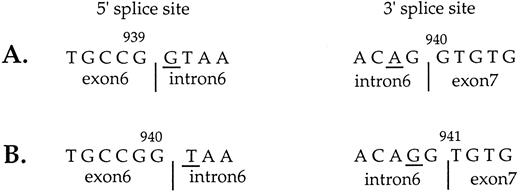To the Editor:
In a recent article,1 Cheng-Han Huang compared RH hybrid genes from dCCee and DCW-phenotypes and claimed that two exon-exon junctions that we described in previous studies2 were misidentified.
We have now resequenced the exon4/exon5 junction, and we do agree that the boundary needs be set to nucleotide positions 634/635 (nt +1 is the A residue of the ATG initiation codon). In contrast, we disagree with the proposed exon6/exon7 boundary that Huang identifies at nucleotide positions 940/941. We have previously suggested2 that this boundary was located between nucleotides 939/940. We have recently analyzed the genomic fragment encompassing exon6 to exon7 from RHD, RHCE, and RH variant genes.3 Sequencing of both exon6-intron6 and intron6-exon7 junctions indeed confirmed our previous result identifying exon6/exon7 boundary at positions 939/940 (Fig 1A). Moreover, setting the exon6/exon7 boundary at positions 940/941, as suggested by Huang (Fig 1B), would disrupt the splice consensus sequence at the invariant +1 and −2 residues at the 5′ donor and 3′ acceptor splice sites, respectively, thus preventing correct intron6 splicing.
Exon6-intron6 and intron6-exon7 junctions in the RH gene. (A) Exon6/exon7 boundary was found at positions 939/940, as we had previously reported.2 (B) Setting exon6/exon7 boundary at positions 940/941, as suggested by Huang,1 results in abnormal 5′ (GT → TA) and 3′ (AG → GG) splice sites. Invariant +1 and −2 residues at the 5′ donor and 3′ acceptor splice sites, respectively, are underlined.
Exon6-intron6 and intron6-exon7 junctions in the RH gene. (A) Exon6/exon7 boundary was found at positions 939/940, as we had previously reported.2 (B) Setting exon6/exon7 boundary at positions 940/941, as suggested by Huang,1 results in abnormal 5′ (GT → TA) and 3′ (AG → GG) splice sites. Invariant +1 and −2 residues at the 5′ donor and 3′ acceptor splice sites, respectively, are underlined.


This feature is available to Subscribers Only
Sign In or Create an Account Close Modal